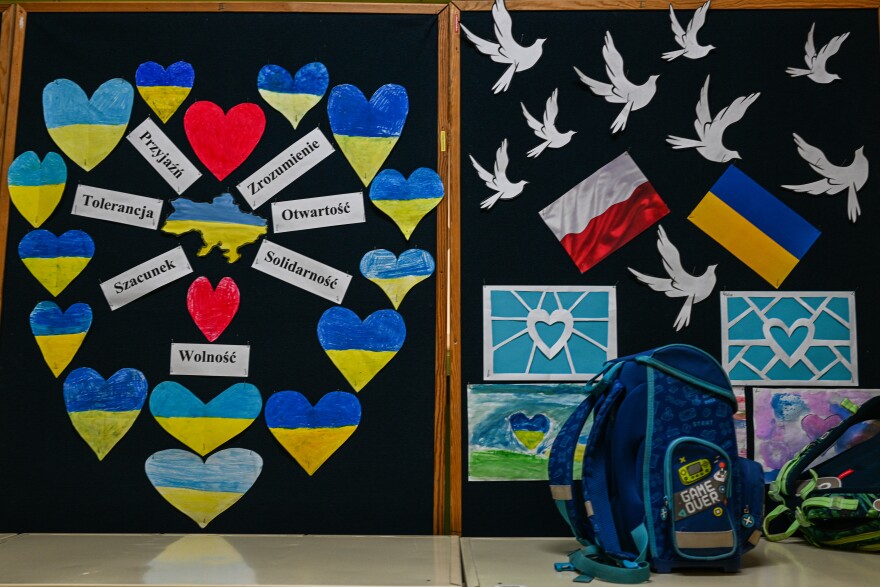It's Tuesday morning and Hanna Kudrinova's 5th grade English class is signed on to Google Meet. Kudrinova starts like a lot of teachers everywhere, with a check-in. She asks the students to turn on their cameras and show a thumbs up if they're happy, thumbs down if they are sad, and sideways if they are feeling so-so.
Today, Maksym Radzievsky, a boy with a round face and a striped shirt who seemingly always has his hand raised, says he is so-so because he's tired. He is in Munich, Germany, in an earlier time zone than Ukraine, so he had to start class at 7:30.
Other students are yawning — one is wrapped in a blanket. Air-raid sirens were going off the night before in the small town near Odessa where they all used to live and study with Kudrinova in person.
Now her students are scattered to the winds — some still at home, some elsewhere in Ukraine, others in Germany, Poland, Czech Republic, even as far as Canada.
Since Feb. 24, more than half the country's children have been pushed from their homes. At least two million are refugees outside the country, a number that grows daily. It's one of the biggest, and fastest, disruptions of children's lives since World War II.
Safety, housing, food, and medical care are the top priorities, but a surprising number of families are also keeping up with school. When the war started, Ukraine's Ministry of Education declared a two-week school holiday. But since then, teaching has resumed remotely.
The Ministry says nearly three million, a majority of the country's school-aged children, have shown up for online learning, at least a bit. The country is even broadcasting video lessons on television.
It may seem surprising, but the world is newly familiar with remote learning thanks to the pandemic. And Ukraine's focus on maintaining education is in line with an emerging philosophy of disaster response — one summed up in the name of a special fund at the United Nations: Education Cannot Wait. The fund has just announced $5 million in donations to help children affected by the war with learning and mental health services.
"Often when you have a humanitarian crisis, you under-prioritize education and focus on water and shelter — which is important," says Yasmine Sherif, the director of the fund. "However, what we have seen from many countries in crisis is that they are protracted — they can last 10, 20, 30 years."
When there is no school and no other organized activity, Sherif says, children's mental health suffers within a few days. Over months or years, children can be pulled into a conflict as soldiers, or risk trafficking and other abuses. And without school, "You will have no dreams and hopes for those millions and millions of children and adolescents, but also no capacity to build a country should peace arrive."
Lessons interrupted by air-raid sirens
It's not easy teaching in the middle of a war. Hanna Kudrinova is 23, and a first-year teacher. She is a fellow with Teach For Ukraine, one of 61 independent international partner organizations of Teach For All, a network co-founded by the founder of Teach For America.
When the war started, Kudrinova fled for the west of the country. Her family, meanwhile, was stuck back in Mariupol, one of the most devastated cities in Ukraine. "It was horrible for me. I was worried about my family and trying to teach at the same time." Her family has since evacuated, and her 14-year-old sister is now staying with her.
Teach For Ukraine gave her and the other fellows some quick training on how to deal with students' psychological challenges. She learned to do the daily mood check-in, and learned some breathing exercises to try to calm the class down when they have to stop the lessons for air-raid sirens.

Some students can't attend every day because they aren't in a safe place or are moving around. Many others are signing in on their parents' phones. Still, Kudrinova says, and experts agree, that the routine of school and seeing their friends online is helping. Otherwise, she said, they are mostly stuck inside all day, watching TikTok or playing Fortnite.
"Even if I'm not teaching the full curriculum, it's good that they're talking to me, they are talking to each other...[it] can remind us of something normal."
The children are experiencing the war on social media, through memes and videos, as well as directly. They don't ask Kudrinova a lot of questions, but it comes up in other ways. One boy, when she asked him to explain the difference between "There is" and "There are," came up with the sentence "There are a lot of dead Russian soldiers in Odessa."
Stay with your classmates or go to a new school?
In countries including Poland and Bulgaria, and in safer parts of Ukraine, there are informal settings that resemble the learning hubs set up in the U.S. during the pandemic. Here, students can sign on to their remote lessons with their teachers and classmates from back home, and also play sports and do other activities in person. Some of these hubs also have support for mothers.
Other children are starting over in new countries.
In Poland, which has received more than a million children from Ukraine, with more arriving every day, there are several different options. Some newcomers are enrolling directly in Polish schools, especially in smaller towns.
Poland is also creating classes with all Ukrainian children and Ukrainian teachers who have also just arrived. These will follow Ukraine's curriculum and be taught in Ukrainian.
Kasia Nabdralik, the CEO of Teach For Poland, another network partner of Teach for All, is helping with staffing: matchmaking newly arrived Ukrainians who have education experience to the various openings.
"In the first week, we're all going and helping with the medical things, with finding shelter," she explained. "We felt like, 'OK, we know that in a week or two, people will start thinking about education.' And we realized that this can be our purpose, to make sure that schools are safe spaces for these kids, because safety and this type of stability is the most important for them."
Farther afield, the efforts to absorb Ukrainian children have been more ad hoc.
Two thousand miles from Odessa, in Dublin, Ireland, there are a few new Ukrainian students in teacher Phil McCarthy's school. He's trained in teaching English as a second language and is a spokesperson for the English Language Support Teachers' Association of Ireland.
He was called in the other day to help with a newly arrived student.
"He was just sitting there lost." He set up the child's teacher with some translation software. His group also held a webinar recently for Irish teachers who want to help students from Ukraine. More than 1,000 people registered. "That's a lot for Ireland," McCarthy says.
More than a dozen different languages are spoken in McCarthy's class. His school is close to a short-term reception center for asylum seekers at the Dublin airport. He said that the other day, maybe prompted by current events, one of his Syrian students had a realization.
"He actually said to me in class ... 'Oh! I'm a refugee!' "

The problem of interrupted education is a lot bigger than this one war. Sherif, of Education Cannot Wait, says that while an estimated 4.5 million Ukrainian children are displaced, worldwide there are 128 million children and youth whose learning is disrupted–by war, climate-exacerbated disasters and the pandemic.
She mentions Afghanistan, where the Taliban has recently barred girls from attending school above 6th grade. Meanwhile, she says, just 2 to 4% of all humanitarian aid goes to education.
She hopes maybe this war, and the outpouring of support from around the world, could change that equation.
If necessary, Ukraine's online classes will continue through the end of the school year. A looming issue is the spring high school and college entrance exams.
For the moment Hanna Kudrinova and her students are carrying on. She says she no longer bothers to pause her own teaching when the air raid sirens go off near her temporary home near Lviv.
Copyright 2022 NPR. To see more, visit https://www.npr.org.









